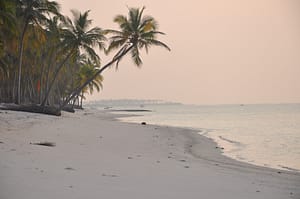The precise history of Lakshadweep is unwritten and is based on various legends and local traditions. It is understood from the legends that the first settlement on these islands date back to the period of Cheraman Perumal. There are citations in the Sangam Patirruppattu, that the islands were controlled by the Cheras. The oldest inhabited islands are Kalpeni, Andrott, Kavaratti, Agatti and Amini. Archeological evidence states, Buddhism prevailed in Lakshadweep during the 5th and 6th century. Islam was brought to Lakshadweep in 661 CE by an Arab named Ubaidulla. The island came under the rule of Late Cholas during the 11th century and subsequently, the Kingdom of Cannanore. The Portuguese ruled the seas between Ormuz and the Malabar Coast and down to Ceylon during the 16th century. They took control of Lakshadweep in the year 1498. The Portuguese ruled Lakshadweep until 1545. Ali Rajahs of Kannur ruled the islands in the 17th century. Later, the Amindivi group of islands came under the rule of Tipu Sultan. After the Third Anglo-Mysore War, they passed it on to British control and were attached to South Canara. The rest of the islands were attached to the Malabar district of the Madras Presidency.
Both music and dance in Lakshadweep are influenced mainly by Islamic culture. Since this union territory is in close proximity to Kerala, the culture is quite similar to that of Kerala. Parichakali dance, Kolkali dance, Lava dance and Opana are some of the popular forms of dance, performed during marriage celebrations and festivals. During important family occasions like child birth, marriage and ear-boring, the true essence of the culture is seen. The vibrant culture of Lakshadweep is portrayed in their traditional tribal dance and folk music. Coir, corals, shells and oysters are beautifully crafted to make ornaments, jewelleries and decorative items, which can be purchased from handicraft shops and street shops on the beach. The cuisine of Lakshadweep is influenced by Kerala, as the two most abundant items found on both these places are coconuts and fishes. However, some of the dishes in Lakshadweep are unique. The food is known for its tangy and spicy taste, with flavours unlike any other.
Majority of the people in Lakshadweep follow Islam and they belong to the Sunni section. The other religions followed by the people of Lakshadweep are, Hinduism and Christianity. They are divided into four main communities, including, Aminidivis, Koyas, Malmis and Melacheris. The Aminidivis are known for their handicraft skills. The Koyas are landowners and the Malmis work under them. The Melacheris belong to the labour community. The people lead a simple lifestyle and are known for their unique rituals. Men usually wear Dhoti and women wear Libu, a long gown which runs from the shoulder to the ankle.

